

Harmony Explained: Progress Towards A Scientific Theory of Music. The Major Scale, The Standard Chord Dictionary, and The Difference of Feeling Between The Major and Minor Triads Explained from the First Principles of Physics and Computation; The Theory of Helmholtz Shown To Be Incomplete and The Theory of Terhardt and Some Others Considered Daniel Shawcross Wilkerson Begun 23 September 2006; this version 19 February 2012.
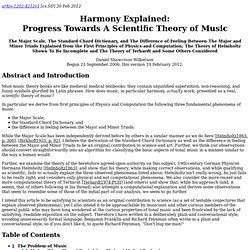
Abstract and Introduction Most music theory books are like medieval medical textbooks: they contain unjustified superstition, non-reasoning, and funny symbols glorified by Latin phrases. A guide to Luciano Berio's music. What are the limits of a musical instrument?

And what are the boundaries of a piece of music? A guide to Witold Lutosławski's music. Now, we're perilously close to the boundaries of our self-imposed criteria for this whole series with the Polish composer Witold Lutosławski, since his centenary is celebrated next week (on the 25th, to be precise), but unlike that other prospective centennial this year, one Britten, B (who won't be in this series for reasons of sufficient exposure here and elsewhere).

Lutosławski's output is, I think, neither well-known nor well understood enough. What pop music owes to the classical masters. Mozart pleases his public The years 1650 to 1750 were a period of feverish invention and technical ingenuity in music that reached an apotheosis in Handel's sublime oratorios and Bach's cantatas and Passions.
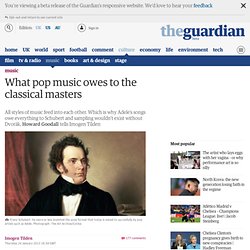
Howard Goodall's top 10 music books. Notes on music ...
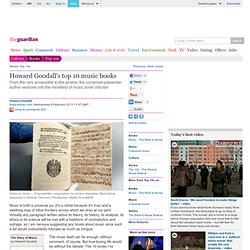
A handwritten composition by Johann Sebastian Bach being displayed in Weimar, Germany. Photograph: Martin Schutt/EPA Music is both a universal joy (it's a cliché because it's true) and a seething map of tribal frontiers across which we stray at our peril. Virtually any paragraph written about its theory, its history, its analysis, its ethics or its science will be met with a hailstorm of contradiction and outrage, so I am nervous suggesting any books about music since such a list would undoubtedly infuriate as much as intrigue.
Steve Reich on Schoenberg, Coltrane and Radiohead. There is something oddly reassuring about the fact that Steve Reich lives in precisely the kind of house you might expect Steve Reich to live in.

The cab journey to Pound Ridge, the tiny town on the New York-Connecticut border that the composer has called home since 2006, passes a lot of rather grand homes built in various classic styles, from colonial to arts and crafts. How composers from Mozart to Bach made their music add up. The Rite of Spring – a rude awakening. At the first performance of The Rite of Spring in May 1913, even well-informed members of the audience had no idea what they were experiencing.
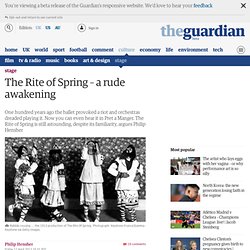
Afterwards, the critic of the French periodical Gil Blas recorded a conversation about the beginning of Stravinsky's prelude to the ballet: "'What instrument produces these sounds? ' I say, 'It's an oboe.' My right-hand neighbour, who is a great composer, insists that it is a muted trumpet. My left-hand neighbour, who is no less of a musical scholar, declares, 'I should have thought it was a clarinet.' In the interval we ask the conductor himself, and we are told that it was a bassoon that gave us such heart-searchings.
" The rest is power: classical music in the age of the dictatorship. In his preface to The Rest Is Noise, Alex Ross writes: "In the classical field it has long been fashionable to fence music off from society, to declare it a self-sufficient language.

" He goes on to contend that while in the "hyper-political 20th century, that barrier crumbles again and again", the "vague, mutable and deeply personal nature of musical meaning" makes the establishment of clear connections – let alone correspondences – between music and the outer world "devilishly difficult". This is in fact a special form of pleading that rests on artificial parameters: implicit in The Rest Is Noise, for all its formal disavowals, there remains an assumed sharp dichotomy between high and low art, and a privileging of the discourse of the former.
This is not to claim that Ross pays no attention to the impact of technological modernity on 20th-century classical music – he most certainly does. Hitler loved music because many humans – including evil ones – love music. How Stravinsky's Rite of Spring has shaped 100 years of music. The Rite of Spring was a revolutionary work for a revolutionary time.
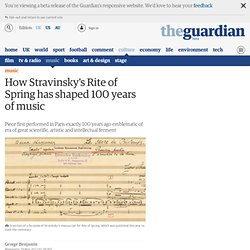
Its first performance in Paris, exactly 100 years ago on Wednesday, was a key moment in cultural history – a tumultuous scandal. Formalized Music: Thought and Mathematics in Composition - Iannis Xenakis. Scales and emotions. See also a post about making chords from scales.

So maybe you want to write a song or an instrumental in a particular mood or style, and you’re feeling overwhelmed by all the scales. Here’s a handy guide to the commonly used scales in Western pop, rock, jazz, blues and so on. Click each image to play the scale right in your browser with the aQWERTYon. These scales have a major third (E in the key of C), which makes them feel happy or bright. Major scale Happy; can be majestic or sentimental when slow. Mixolydian mode Bluesy, rock; can also be exotic/modal. Lydian mode. MusicalMind.org Ear Training Online. Rhinegold Publishing: Music, the Arts & Education. Silence: Lectures and Writings - John Cage. The Music of the Spheres: Music, Science, and the Natural Order of the Universe - Jamie James. Websites - bocpages - the unofficial boards of canada wiki.